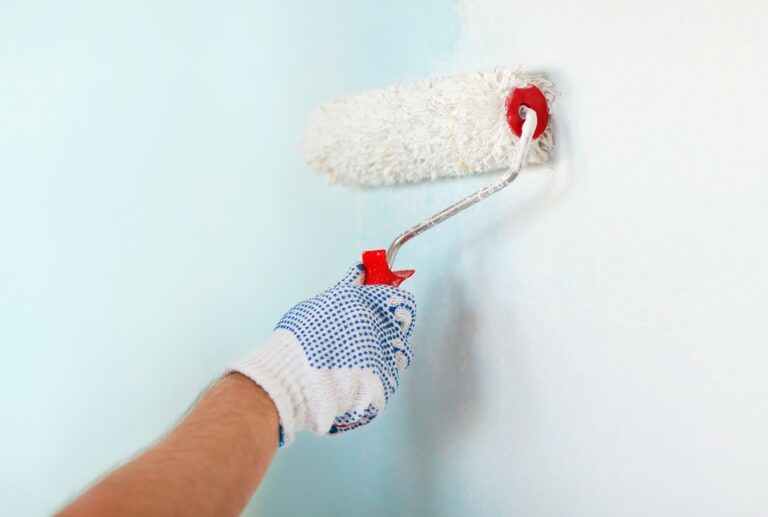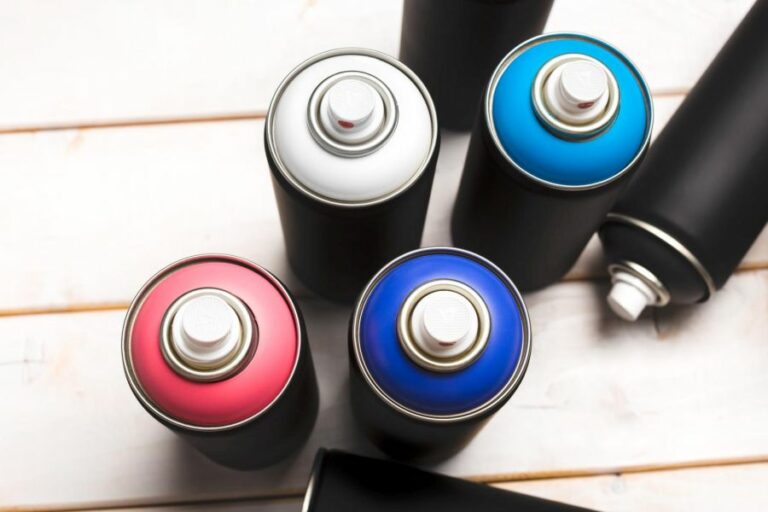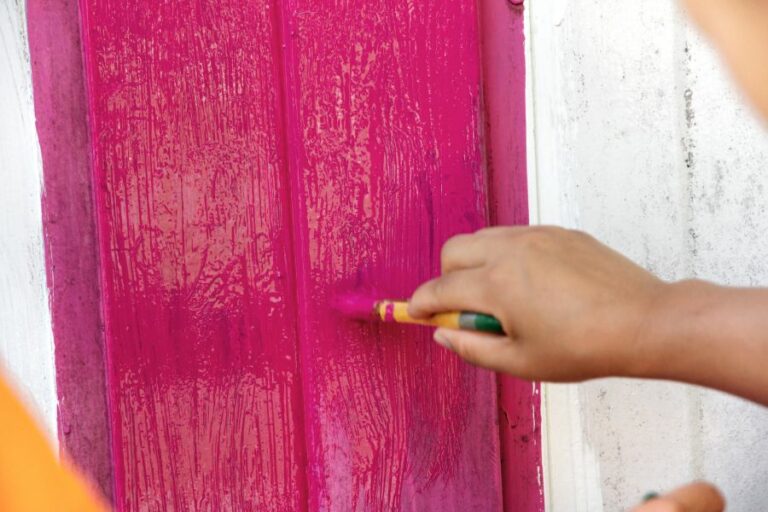Paint Or Stain Outdoor Wood Furniture, 25 Things You Should Know
You’ve invested time and money in your outdoor wood furniture, so it’s natural to want to protect and enhance its appearance. But the big question is, paint or stain? Let’s dive into each option’s differences, benefits, and drawbacks to help you make a well-informed decision on which is best for your outdoor wood furniture.
Paint or stain outdoor wood furniture:
Choosing between paint and stain for outdoor wood furniture depends on personal preferences, desired look, and maintenance effort. Paint offers long-lasting protection, bold colors, and easy maintenance, while stain preserves the wood’s natural look, dries faster, and allows the wood to breathe. Consider durability, protection, and finish uniformity when making a decision.
Elevate your outdoor space with the right finish for your wood furniture! Discover the pros and cons of painting versus staining, along with my expert tips and tricks to help make your decision easier. From choosing the right paint or stain to application techniques, I’ve got all the details you need, so read on!
Contents
- 1 Selecting Paint or Stain for Outdoor Wood Furniture: A Professional Guide
- 2 Should Outdoor Wood Furniture be Painted or Stained: Comparing the Best Options
- 3 Which has greater durability for exterior use: paint or stain?
- 4 Which is Superior for Wood Finishing: Painting or Staining?
Selecting Paint or Stain for Outdoor Wood Furniture: A Professional Guide
One of the best ways to keep your outdoor wood furniture looking fresh and attractive is by applying a coating to protect it from the elements. Two popular options are paint and stain, and each has its own set of advantages and drawbacks.
• The Benefits of Paint for Outdoor Wood Furniture
– Long-lasting Protection
There’s a reason why paint is a popular choice among homeowners who want to give their outdoor wood furniture a fresh new look. High-quality exterior paint can provide several years of protection against harsh sun, rain, and snow, even in regions with extreme weather conditions.
In my experience, I’ve found that a properly-prepared and painted piece of outdoor furniture can easily last up to 10 years without the need for re-application.
– Unlimited Color Options
One of the outstanding benefits of paint is the wide array of colors to choose from. Unlike stain, which typically highlights the wood’s natural color, paints completely mask the wood grain, allowing you to create a bold, dramatic appearance that reflects your personal style.
This can be particularly appealing if you’re looking to create a statement or coordinate your outdoor space with other elements, such as planters or outdoor cushions.
– Ease of Maintenance
Perhaps one of the most significant reasons for choosing paint over stain is the ease with which it can be maintained. Unlike stains, which may require frequent touch-ups and re-application, paint can easily be cleaned and maintained with simple soap and water.
If the surface starts to look dull or damaged over time, a quick touch-up can breathe new life into your outdoor wood furniture.
• The Benefits of Staining for Outdoor Wood Furniture
– Preserving the Natural Look of Wood
For many homeowners, the choice to use stain over paint is a simple one. Stain allows you to preserve and enhance the beauty of the wood’s natural grain while still offering protection from the elements.
This can provide a more organic and authentic feel to your outdoor space, creating a comfortable, inviting atmosphere.
– Faster Drying Time
Stain tends to dry much faster than paint, making it a more convenient option for projects where time is of the essence. Waiting for paint to dry, especially when applying multiple coats, can be a tedious process.
Stain, on the other hand, may require only a single coat and could be dry to the touch within hours.
– Increased Breathability
One often overlooked advantage of stain is its ability to let the wood “breathe” more than paint. Wood naturally expands and contracts due to weather changes, and allowing it room to breathe can reduce the likelihood of cracks, warping, or other damage.
Stain penetrates the wood, whereas paint forms a solid, impermeable layer on top.
• Drawbacks and Considerations
– Durability and Protection
A stain may not provide the same level of durability that paint offers, especially when it comes to protecting wood from moisture. This can be particularly concerning if you live in a humid environment, where moisture damage can be quite common.
To help combat this issue, it’s recommended to apply a clear, water-resistant sealant in addition to the stain. However, this can add another step to the process, making it more time-consuming and labor-intensive than painting alone.
– Difficulty in Achieving a Uniform Finish
Although stain products have improved over the years, they can still be challenging to apply uniformly, even for experienced DIYers. The wood’s natural color and grain can cause the stain to absorb unevenly, creating an inconsistent finish. Paint, on the other hand, provides a more uniform, solid coverage.
• Conclusion
Ultimately, the decision to use paint or stain for your outdoor wood furniture will depend on your personal preferences, desired look, and how much time and effort you want to invest in maintenance. If you want a long-lasting and bold color, the paint may be your best option.
However, if you prefer to let the natural beauty of the wood shine through, a high-quality stain could be just what you need.
For more in-depth information about outdoor wood furniture protection, the U.S. Forest Service provides a comprehensive publication on the topic, which covers everything from the types of finishes to best application practices.
Should Outdoor Wood Furniture be Painted or Stained: Comparing the Best Options
When it comes to outdoor wood furniture, selecting the right finish is crucial for both appearance and durability. There are two popular options: painting and staining.
Both have their advantages and disadvantages, and the choice ultimately depends on your personal preference and the specific needs of your outdoor space.
• The Basics of Painting Outdoor Wood Furniture
Paint is known for its ability to provide vibrant, long-lasting color and a uniform appearance. It is available in a wide range of colors and finishes, allowing you to customize the look of your outdoor furniture to suit your design preferences.
– Advantages of Painting
- Durability: High-quality exterior paint forms a protective layer on the wood’s surface, shielding it from the elements and preventing UV rays from causing fading and discoloration. This protective layer can also help to prevent moisture damage, which can lead to rot and decay.
- Versatility: Paint allows for a wide range of colors, textures, and styles, making it easy for you to customize your furniture to match your outdoor decor.
- Easy Maintenance: Painted surfaces can be cleaned with mild soap and water, making it simple to remove dirt and grime.
– Disadvantages of Painting
- Preparation time: Painting often requires more surface preparation, including sanding and priming, to ensure proper adhesion and a smooth finish.
- Less Natural Appearance: Paint tends to create a solid, opaque surface that can mask the natural beauty of the wood grain.
- Difficulty in Stripping and Refinishing: When it’s time to refinish your painted outdoor furniture, the process can be labor-intensive since it requires the removal of the old paint before applying a new coat.
• The Basics of Staining Outdoor Wood Furniture
Wood stains are designed to enhance the natural beauty of the wood while providing some protection from the elements. Stains come in a variety of colors and opacity levels, ranging from transparent to solid colors.
– Advantages of Staining
- Natural Appearance: Staining provides a more natural-looking finish, allowing the wood grain and texture to show through. This can be particularly appealing for those who appreciate the beauty and character of natural wood.
- Easier Application: Staining typically requires less preparation than painting, with no need for a primer in most cases. This can make the refinishing process quicker and more straightforward.
- Longevity: Stains can be easily recoated without the need to strip the old finish, making future maintenance more manageable.
– Disadvantages of Staining
- Less Durability: While quality stain products can offer some protection against the elements, they generally provide less shielding from UV rays and moisture than paint. This means your outdoor wood furniture may be more susceptible to fading, discoloration, and deterioration over time.
- Limited Color Choices: Stain options typically offer a more limited color range compared to paint, which can be a drawback for some homeowners who want a specific color for their outdoor space.
- Frequent Maintenance: Stained wood furniture usually requires more frequent maintenance, including regular reapplication of stains and occasional cleaning, to maintain its appearance and protection.
• Which Option is Best for Your Outdoor Wood Furniture?
When deciding whether to paint or stain your outdoor wood furniture, consider your personal design preferences, the type of wood, and the environmental conditions in your area.
- If you prefer a more natural appearance that showcases the wood grain, staining may be the better option.
- If you’re looking for bold colors or a more uniform finish, painting might be the way to go.
- For wood species that are naturally resistant to rot and decay (like cedar, redwood, or teak), staining can be a good choice to maintain their natural beauty.
- If your furniture will be exposed to harsh weather conditions, you may want to opt for paint to provide greater protection.
In either case, it’s important to use high-quality exterior paint or stain products designed for outdoor wood furniture to ensure long-lasting results. Make sure to follow the manufacturer’s instructions for surface preparation, application, and maintenance.
– Personal Recommendation
As someone with experience in finishing outdoor wood furniture, I recommend checking out the Forest Products Laboratory website for further guidance on selecting the right finish for your specific wood type and environmental conditions.
This will help you make an informed choice and achieve the best results for your outdoor wood furniture project.
In conclusion, both painting and staining outdoor wood furniture have their pros and cons, and the best choice for you will depend on your design preferences, the type of wood, and the specific needs of your outdoor space.
By weighing the advantages and disadvantages of each option and considering your unique requirements, you can select the finish that will enhance the beauty and durability of your outdoor wood furniture for years to come.
Which has greater durability for exterior use: paint or stain?
Whether you’re tackling a home renovation project or planning to refresh the look of your outdoor space, you might have faced the decision of using either paint or stain.
These two options might appear similar, but they serve different purposes, and each has its own set of advantages and disadvantages. One of the major factors to consider when choosing between paint and stain is longevity, or how long the chosen product will hold up under the elements.
• A Brief Overview of Paint and Stain
Before diving into the details of longevity, it’s important to understand the key differences between paint and stain.
– Paint
Paint is a thick, opaque substance that provides an even, solid color across the surface it is applied to. It dries to a smooth, hard finish that serves to protect the surface it covers.
Outdoor paint products are specially formulated to withstand the elements and maintain their appearance for an extended period of time.
– Stain
Stain, on the other hand, is a liquid product that is absorbed by the surface it is applied. Instead of laying on top of the surface like paint, stain penetrates the wood, giving it a natural and sometimes uneven appearance.
Stains are typically more transparent, allowing the wood’s texture and grain to show through. Stains come in a variety of colors and finishes, including solid, semi-transparent, and transparent.
• Factors Influencing the Longevity of Paint and Stain
Several factors can impact the performance of paint and stain products, causing them to deteriorate over time.
– Weather Conditions
Both paint and stain are susceptible to damage from the elements, such as rain, snow, heat, and sunlight. Harsh weather conditions can cause paint to crack, peel, or fade, while stains can wear away, leaving bare wood exposed.
– Surface Preparation and Application
Proper surface preparation and application techniques play a significant role in the longevity of paint and stain. Surfaces should be cleaned, sanded, stripped, and primed (if necessary), ensuring that the product adheres well and does not face any challenges in withstanding the test of time.
– Maintenance
Regular maintenance and upkeep can help prolong the lifespan of both paint and stain finishes. When properly cared for, paint and stain can keep an outdoor living space looking fresh for several years.
• Longevity: Paint vs. Stain
When it comes to longevity, paint generally outlasts stains in terms of durability on exterior surfaces.
– Paint
When applied correctly, high-quality exterior paint can last anywhere from 5-10 years or even longer, depending on the quality of the paint, how well the surface was prepared, and the environmental factors that affect the surface.
Paint provides a strong barrier between the surface of the wood and the elements, which helps prevent wear over time.
– Stain
On average, stains may last between 2-5 years, depending on the type of stain used and the environmental conditions it is exposed to. Transparent and semi-transparent stains may need more frequent reapplications, while solid stains generally last longer due to their stronger pigmentation.
However, it is important to note that the longevity of the paint on surfaces like decks or railings, where there is a lot of foot traffic and surface wear, may be shortened. In such cases, the stain may be the wiser choice as it tends to tolerate wear and tear better than paint and is easier to touch up.
• Personal Recommendations
Based on personal experience, I recommend the following in terms of choosing between paint and stain for outdoor projects:
- For siding, fences, or features where you want a solid color and a smooth finish, consider using paint. Ensure that both the product and application methods are suited for outdoor use.
- For decks, railings, or surfaces that are prone to wear and tear, use stain. It is easier to touch up, and it offers better adhesion on horizontal surfaces that are exposed to more foot traffic.
- If you desire a more natural look that showcases the wood grain, a stain is an ideal choice.
Lastly, it might be helpful to visit websites like The U.S. Department of Energy or the U.S. Environmental Protection Agency for information on energy-saving and environmentally-friendly practices that can help extend the life of your outdoor projects.
In conclusion, while paint typically offers better durability and longevity, the specific needs and characteristics of your outdoor project should be considered when deciding between paint and stain.
By taking into account factors such as weather conditions, maintenance, and desired appearance, you can make the best choice for the long-term success of your project.
Which is Superior for Wood Finishing: Painting or Staining?
When it comes to enhancing the appearance of wood and protecting it from the elements, we can choose between painting or staining the wood.
Both methods have their pros and cons, and deciding which one is better for you depends on various factors, such as the type of wood you have, the desired look, and the amount of maintenance you’re willing to put in.
Let’s dive into the specifics of painting and staining wood, and see which option is best-suited for your needs.
• Pros and Cons of Painting Wood
– Advantages
Enhanced Protection
Painting creates a thick, solid barrier that effectively protects wood from moisture, UV rays, and other environmental factors. This is particularly important for exterior wood structures, like decks, fences, and siding.
The level of protection provided by paint helps to prevent wood rot and extends the life of the wood.
Wide Range of Colors and Styles
Painting allows you to choose from virtually endless colors and finishes. This means you can easily match your wood structures to your home or other exterior elements, allowing for greater creativity and personalization.
Longevity
A well-applied, high-quality paint can last up to 10 years before needing a touch-up or repainting. As a result, painting is generally seen as a more long-term solution compared to staining.
– Disadvantages
Hides Natural Wood Features
Due to its opacity, paint covers the wood’s natural grain and texture. While this can be an advantage for those looking for a specific color or style, it’s a disadvantage for those who wish to showcase the natural beauty of the wood.
More Labor-Intensive
Preparation, application, and maintenance of paint are generally more time-consuming and labor-intensive than staining. Painting often requires multiple coats, and if the wood peels or chips, maintenance can be tedious.
Difficulty in Removing
In case you decide to switch from paint to a different finish or to natural wood, removing paint can be challenging and time-consuming, requiring the use of chemicals or specialized tools.
• Pros and Cons of Staining Wood
– Advantages
Preserves Natural Beauty of Wood
Stains are available in transparent, semi-transparent, and solid varieties. Transparent and semi-transparent stains allow the wood’s natural grain and texture to show through, enhancing its beauty while still providing protection.
Easier Application and Maintenance
Staining typically requires fewer coats and less preparation than painting. Maintenance is also simpler, as stained wood doesn’t chip or peel like paint. When it’s time to re-stain, little or no surface preparation is needed, making the process quicker and less labor-intensive.
Better Penetration
Stains are formulated to penetrate the wood fibers, which helps provide better protection against moisture and natural decay.
– Disadvantages
Limited Color Options
While stains are available in various shades, the range of colors is more limited than with paint. Additionally, the final color may vary depending on the type and color of the wood being stained.
Less Protection from UV Rays
While all types of stains provide some UV protection, transparent and semi-transparent stains offer less protection than paint, potentially leading to wood discoloration and damage over time.
Shorter Lifespan
Depending on the type of stain used and the environmental conditions, staining may need to be reapplied every 2 to 5 years. This makes staining a more frequent maintenance task compared to painting.
• Which One to Choose: Paint or Stain?
In conclusion, choosing either to paint or stain wood depends on several factors. If you wish to preserve the natural appearance of the wood and are willing to reapply the finish more often, staining may be the better option.
However, if you’re looking to achieve specific colors, need greater UV protection, and prefer a longer-lasting finish, painting may be the right choice.
Remember to consider the type of wood, intended use, and climate in your area before making your decision. Additionally, selecting a high-quality product and following proper application and maintenance techniques are essential to achieve the best results with either paint or stain.
For further in-depth advice on both painting and staining, I recommend visiting the United States Department of Agriculture’s Forest Products Laboratory website, which offers valuable resources and guidance on wood preservation and finishing.

